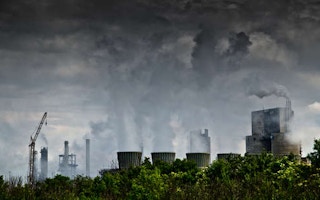The amount of air pollutants emitted by thermal power plants and steel factories in the north of China that provide real-time emissions data online frequently exceeds emissions standards , according to a report released by a Beijing-based environmental organization on Tuesday.
The report, entitled “Blue Sky Roadmap”, is a second phase investigation on atmospheric pollution. It said that in provinces such as Shandong and Hebei, a lot of large-scale enterprises had emissions that seriously exceeded standards, even during a period of severe air pollution.
The report was jointly released by the Institute of Public and Environmental Affairs (IPE), Renmin University Institute of Environment and Planning, the SEE Foundation, Friends of Nature, Envirofriends and Nature University.
An unprecedented amount of smog shrouded large areas of China in January last year, leaving around 600 million people in 17 provinces affected, almost one quarter of China’s territory, said Ma Jun, director of IPE.
The widespread smog has helped to push forward an aggressive government action plan to curb China’s serious air pollution problems. The State Council issued the toughest-ever Action Plan for Air Pollution Prevention and Control (2013-17) in September 2013, claiming that China will improve its air quality over a five year span.
The report concluded that emissions reduction must be focused, and should start with controlling large scale sources of pollution, which can be identified from online air quality data disclosures and major emitters in real time.
A total of 179 cities were releasing air quality information in real time as of Jan. 2, 2014, the study said. Residents of these cities can use their computers, and even their smart phones, to check all the available air quality information. Real time disclosure has highlighted serious pollution, which has prompted several areas to develop emergency contingency plans for periods of severe pollution.
The Ministry of Environmental Protection issued a new regulation in July last year, requiring all provinces to establish an online platform to disclose real-time online monitoring data from major emitters. Shandong, Zhejiang and Hebei were among the first to start to do so. “The good practice shown in these provinces has helped to give the public the right to know, and helps identify the main pollution sources within that geographical region,” Ma said.
Based on present online monitoring data of major emitters, the study concluded that about 4,000 enterprises in the thermal power, steel, cement, refining, petroleum and petrochemical industries contributed about 65 percent of China’s industrial emissions.
“The government should strengthen its supervision over these polluting companies. The media should expose incidents of pollution, and environmental organizations and attorneys should litigate polluters, and banks should restrict loans to these companies,” said Ma.
The report also pointed out that if enterprises in key regions like Shandong and Hebei were to comply with emissions standards, including the new standards to come in within the next year, their nitrogen oxide discharge volume would be significantly reduced.










